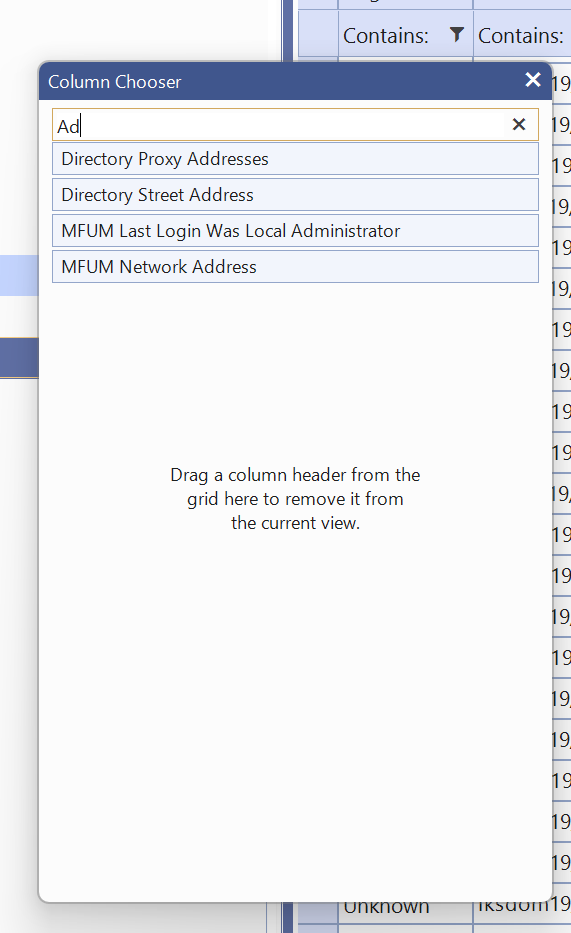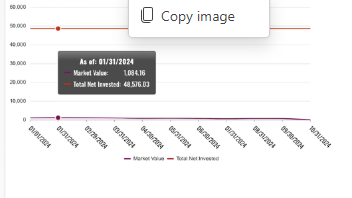It will be really useful if we could include a new 'filtering mode' in which operators like 'and' or 'or' are allowed in the filtering input box.
For instance, using the "doesnotcontain" with 'march or july or september' will allow users to exclude multiple conditions in a single filter
In my application, I have grids with dozens of hidden fields.
It would be beneficial if I could filter the available columns similar to what's available in the Windows Forms column chooser:
Hi Guys,
Just upgrade to the 2025.1.211 release and during testing I have spotted a fundamental issue which should have been picked up during QA.
Run the following dojo
https://dojo.telerik.com/dBSXoLYq
Open up the filter menu on the date column and hit the icon and you will find the date pop-up is constrained within the filter menu and cannot be navigated.
See attached screenshot - DateFilter.png
Note: This also effects filtering Date Time columns as well
Is there a workaround for this or do we have to wait another couple of months for the next release because as things stand we cannot pushed this to production.
Regards
Alan.
Would like to request that the ability to set a 'CenterTemplate' be added to the Radial and Linear Gauge charts. We show a percentage based label using jquery by appending to the chart wrap a label to show 'x of y (z%)'. What we've seen is that when you go to export the chart, this label doesn't follow with it.
When using other charting types, for example the Arc Gauge or Circular Gauge, they do have a property called 'CenterTemplate' which allows us to do labels like above and have it export correctly.
Can the property be added to other Charts so that we can customize a label to show information such as percentage based text?
Hi,
We have some multiselect controls which can have a large number of values, and selected values. This causes an issue where the height becomes unreasonably large compared to other controls.
For a typical example of the issue, see here: Multiselect height issue | Kendo UI Dojo
As can also be seen in the provided example, setting max-height with an overflow isn't a viable solution as then it becomes very difficult to see what has been selected - the vertical scroll is much too quick (at least it is using my mouse which has discrete scroll values). Also, there are both dropdown buttons and scroll buttons which is ugly and confusing for end users.
Our suggestion to resolve this would be to add an option for a "single line mode" so that functionality is not broken for other clients. When using this mode, all the items will be kept in a line. In the event of an overflow, then you could either a) cut off the items with an ellipsis "..." or b) enable horizontal scrolling (ideally without a visible scrollbar).
See this example in the DevExpress controls for an example of horizontal scrolling in "Single line mode".
JavaScript/jQuery Tag Box - Overview | jQuery/JS Example
You can see that when all the items are selected, the height is kept consistent. It is still reasonably easy to read as you can easily scroll along.
Something similar to this solution would be ideal for us.
See demo page: https://docs.telerik.com/kendo-ui/api/javascript/ui/colorpicker/configuration/clearbutton
The example uses "<input id="colorpicker" type="color" />". Opening the preview reveals a black color.
Change the input-tag to div and the 'clear'-style is presented in the preview.
Or remove the color type when using the input-tag: "<input id="colorpicker" />" also correctly represents clear.
I can also locally reproduce it with Kendo UI jQuery v2024.4.1112.
Example: https://runner.telerik.io/fullscreen/yypoqSea
This example is based on the example from the docs with `navigatable: true` and enough data that the user needs to scroll in order to see the bottom row.
On Chrome on macOS, the filter menu cannot be used when `navigatable: true` and "Tap to click" is enabled in the macOS Trackpad settings. When clicking on the filter icon, the menu disappears very quickly (see screen recording). As a workaround, setting `navigatable` to false seems to resolve the problem. The same issue does not seem to occur on Safari, however, there is still odd behavior with the scrolling.
For some reason, screen size, resolution, and window settings impact the ability to reproduce the issue. The most reliable way for me to reproduce the issue was with Chrome in full screen on a 16-inch MacBook (13-inch works too) with the bookmarks bar showing and no external displays connected. Hiding the bookmarks bar or not using full screen seems to make it more difficult to reproduce.
Bug report
Line Chart Crosshair doesn't display on iPad iOS 17
Reproduction of the problem
Dojo: https://dojo.telerik.com/mGtuUvac
Expected/desired behavior
Crosshair shall display on tap
Environment
Browser: [all]
Hello,
We're interested in a date input wheel (see attached images) as it is a feature that is especially for useful for mobile users. Telerik's technical support directed us here since the date widget doesn't offer this feature currently.
Kind regards
Bug report
This is a continuation of the following issue.
Probably related to:
https://source.chromium.org/chromium/chromium/src/+/62d86ddddc8fad157321e42e2acdb18b6ebba951
Reproduction of the problem
- Open the following Dojo in a browser running under the Chromium engine.
- Notice that there is a an console error which showcases sporadically, indicating the following.
Current behavior
The animation container's aria-hidden attribute causes a console error in Chrome and Edge.
Expected/desired behavior
The animation container's aria-hidden attribute should not cause a console error in Chrome and Edge.
Environment
- Kendo UI version: 2024.4.1112
- Browser: [Chrome, Edge]
https://dojo.telerik.com/yBSdUQYS demonstrates the issue:
When a grid detail row is expanded, and pushUpdate() is called on it, the row collapses.
What is expected is for the grid row to remain in its prior state (expanded or collapsed.)
Until this is fixed, is there a work-around, other than manually re-expanding the detail row(s)? This is not a feasible work-around in which multiple nested grid rows are collapses and re-expanded, as this causes the UI to jump unexpectedly for the user.
Hi,
We are facing issue on every popup and context menu open. aria-hidden property has been set to true by default while rendering the control.
Blocked aria-hidden on an element because the element that just received focus must not be hidden from assistive technology users. Avoid using aria-hidden on a focused element or its ancestor.
Original ticket:
START
As title says, when a list box is both draggable and multiple select is enabled the behavior is unpredictable. Sometimes when you click and drag on an item it will create the selection box when you are trying to simply drag the item, and other times the opposite. As far as I can tell there is no way to force one behavior or another.
$("#pdfPreviewList").kendoListBox({
draggable: true,
connectWith: "proposal",
selectable: "multiple",
dropSources: ["proposal"],
template: `
<div id='#:file#'>
#:pn#
</div>`,
toolbar: {
tools: ["moveUp", "moveDown", "transferTo"]
},
change: (e) => {
let f = e.sender.select()[0].getElementsByTagName("div")[0].id;
displayPdfPrview(f)
}
});Data source is 2 -3 items, so there is white space below the list items.
END
I think there should be a dragToSelect option like there is in grid. That way you can still have multiple select work with key modifiers like control and shift and can also have dragging without worrying about the box select interfering with it.
maybe something like
select: "multiple" // normal selection *without* box selection
select: "dragToSelect" // selection with box selection and all the other features of "multiple" such as key modifiersAlso potentially a warning if dragToSelect and draggable are active at the same time to notify the developer that this combination may lead to unexpected behavior.
Thank you
Expose a Cron-Like Scheduler following an example found here https://crontab.guru/.
Line Chart Crosshair doesn't display on Tablets.
Display's fine on Desktop & also on Mobile, but tested on iPad and Android tablets the Crosshair line does not display.
kendo.2020.1.114
there is no binding for noData
e.g.
noData?: boolean | undefined; interface ChartOptions {
name?: string | undefined;
autoBind?: boolean | undefined;
axisDefaults?: ChartAxisDefaults | undefined;
categoryAxis?: ChartCategoryAxisItem | ChartCategoryAxisItem[] | undefined;
chartArea?: ChartChartArea | undefined;
dataSource?: any|any|kendo.data.DataSource | undefined;
legend?: ChartLegend | undefined;
panes?: ChartPane[] | undefined;
pannable?: boolean | ChartPannable | undefined;
pdf?: ChartPdf | undefined;
persistSeriesVisibility?: boolean | undefined;
plotArea?: ChartPlotArea | undefined;
renderAs?: string | undefined;
series?: ChartSeriesItem[] | undefined;
seriesColors?: any;
seriesDefaults?: ChartSeriesDefaults | undefined;
theme?: string | undefined;
subtitle?: string | ChartSubtitle | undefined;
title?: string | ChartTitle | undefined;
tooltip?: ChartTooltip | undefined;
transitions?: boolean | undefined;
valueAxis?: ChartValueAxisItem | ChartValueAxisItem[] | undefined;
xAxis?: ChartXAxisItem | ChartXAxisItem[] | undefined;
yAxis?: ChartYAxisItem | ChartYAxisItem[] | undefined;
zoomable?: boolean | ChartZoomable | undefined;
axisLabelClick?(e: ChartAxisLabelClickEvent): void;
dataBound?(e: ChartDataBoundEvent): void;
drag?(e: ChartDragEvent): void;
dragEnd?(e: ChartDragEndEvent): void;
dragStart?(e: ChartDragStartEvent): void;
legendItemClick?(e: ChartLegendItemClickEvent): void;
legendItemHover?(e: ChartLegendItemHoverEvent): void;
legendItemLeave?(e: ChartLegendItemLeaveEvent): void;
noteClick?(e: ChartNoteClickEvent): void;
noteHover?(e: ChartNoteHoverEvent): void;
noteLeave?(e: ChartNoteLeaveEvent): void;
paneRender?(e: ChartPaneRenderEvent): void;
plotAreaClick?(e: ChartPlotAreaClickEvent): void;
plotAreaHover?(e: ChartPlotAreaHoverEvent): void;
plotAreaLeave?(e: ChartPlotAreaLeaveEvent): void;
render?(e: ChartRenderEvent): void;
select?(e: ChartSelectEvent): void;
selectEnd?(e: ChartSelectEndEvent): void;
selectStart?(e: ChartSelectStartEvent): void;
seriesClick?(e: ChartSeriesClickEvent): void;
seriesHover?(e: ChartSeriesHoverEvent): void;
seriesOver?(e: ChartSeriesOverEvent): void;
seriesLeave?(e: ChartSeriesLeaveEvent): void;
zoom?(e: ChartZoomEvent): void;
zoomEnd?(e: ChartZoomEndEvent): void;
zoomStart?(e: ChartZoomStartEvent): void;
}
var chart = $("#chart").data("kendoChart");
var series = [];
$(theData.Serieses).each(function (index) {
series.push({
name: theData.Serieses[index].Name,
field: theData.Serieses[index].Name,
data: theData.Serieses[index].SeriesPoints,
xField: "X",
yField: "Y",
color: theData.Serieses[index].Colour,
markers: {
type: theData.Serieses[index].Shape
}
});
});
chart.setOptions({ series: series, noData: series.length == 0 });
chart.redraw();
console.log(chart.options);When updating a chart after instantiation, because noData defaults to true, the overlay is shown immediately
if you try and set noData via setOptions then redraw(), the overlay is still in place
Honestly, this should have been marked as a breaking change as every single chart has to be updated to force noData to false just to show initially
While upgrading and testing the latest 2024.4.1112 release I have noticed the loading indicator, for both the ComboBox and MultiColumnComboBox, has moved from the dropdown button to inside the edit control.
Is this a a bug or a design decision?
If it is the latter I can find no mention of this breaking change in the release notes, or were you hoping nobody would notice?
To me the old design whereby the loading indicator replaced the dropdown arrow was more logical giving the impression to a user the button was unavailable.
So my finial question ... How do we get the old functionality back?
Regards
Alan



